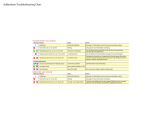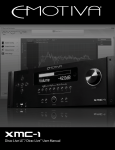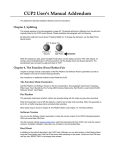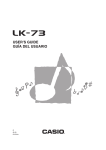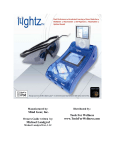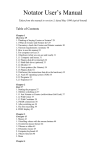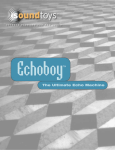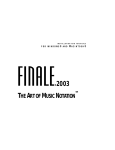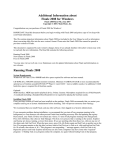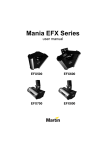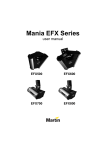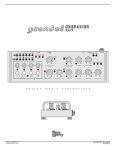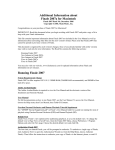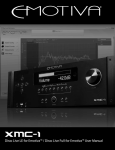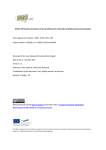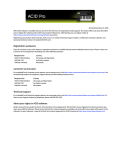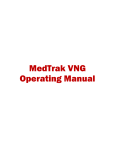Download Kurzweil Mark 152/12 Version 2.0 User`s Guide Addendum
Transcript
KURZWEIL MARK 12 USER’S GUIDE ADDENDUM Kurzweil Mark 152/12 Version 2.0 User’s Guide Addendum In our ongoing effort at Kurzweil to make your musical experience on the Mark 152/12 as rewarding as possible, we have made a number of improvements and added several new features to the instrument. This document describes these changes that make up Version 2.0 of the Kurzweil Mark 152/12. All changes described in this Addendum apply identically to the Mark 152 and Mark 12 models. 910320 1 KURZWEIL MARK 12 USER’S GUIDE ADDENDUM TABLE OF CONTENTS AUTO ACCOMPANIMENT PAGE Style Editor ......................................................................................................................... 4 UNDERSTANDING STYLES ................................................................................. 4-6 HOW TO RECORD A STYLE ................................................................................ 6-8 Setting Up ........................................................................................................... 6-7 Start Recording .................................................................................................. 7-8 Auditioning Your Style ............................................................................................ 8 STYLE RECORDING OPTIONS .............................................................................. 8 COPYING A STYLE FOR EDITING ......................................................................... 9 IMPORTING SONG DATA FROM THE RECORDER ......................................... 9-10 OTHER STYLE EDITING FEATURES ...............................................................10-11 Volume ................................................................................................................. 11 Pan ....................................................................................................................... 11 Chord Change Mode ............................................................................................ 11 Wrap Point ............................................................................................................ 11 Effects Mode ......................................................................................................... 11 Part Sound Override ............................................................................................. 11 STYLE KEY OF COMPOSITION (TRANSPOSE) .................................................. 12 CREATING AN AUTO SETUP ................................................................................ 12 SAVING EDITED STYLES ..................................................................................... 12 New ‘Auto Chord’ Feature ................................................................................................ 12 Chord Reader Enhancement ........................................................................................... 12 RECORDER Song Track Features ........................................................................................................ 13 TRACK COPYING .................................................................................................. 13 TRACK DELETING ................................................................................................ 13 Event Editor ................................................................................................................. 13-15 EDITING EVENTS ................................................................................................. 14 NOTE ..................................................................................................................... 14 PROGRAM CHANGE ............................................................................................ 14 CONTROLLER ....................................................................................................... 15 PITCH BEND .......................................................................................................... 15 AFTERTOUCH ....................................................................................................... 15 NOTES OFF ........................................................................................................... 15 LOOP ..................................................................................................................... 15 TRACK END ........................................................................................................... 15 Recording a Tempo Track ................................................................................................ 16 2 910320 KURZWEIL MARK 12 USER’S GUIDE ADDENDUM TABLE OF CONTENTS (continued) EDU-GAMES Rhythm CopyCat .............................................................................................................. 17 RHYTHM COPYCAT PARAMETERS .................................................................... 17 Rhythm Builder ................................................................................................................. 18 RHYTHM BUILDER PARAMETERS ...................................................................... 18 Scale Tester ..................................................................................................................... 19 SCALE TESTER PARAMETERS ........................................................................... 19 MISCELLANEOUS NEW FEATURES Octave Shift ...................................................................................................................... 20 Changing Rotary Speed Using Pedals ............................................................................. 20 Disk Play Features ........................................................................................................... 20 CHANNEL MUTES ................................................................................................. 20 VOLUME CONTROL .............................................................................................. 20 Disk Load/Save ................................................................................................................ 21 Key Touch Adjustment Using Pedals ............................................................................... 21 Enhanced Panel Memory ............................................................................................ 21-22 PANEL MENU ........................................................................................................ 21 PANEL MEMORY STEPPING ................................................................................ 21 PANEL MEMORY RESET ...................................................................................... 22 USER VARIATION FROM PANEL MEMORY ........................................................ 22 PEDAL ASSIGNMENTS ......................................................................................... 22 New MIDI Master Page .................................................................................................... 22 Metronome Volume Setting .............................................................................................. 22 Enhanced Harmony Feature ............................................................................................ 23 Tempo Change Menu ....................................................................................................... 23 910320 3 KURZWEIL MARK 12 USER’S GUIDE ADDENDUM AUTO ACCOMPANIMENT Style Editor AUTO ACCOMPANIMENT Style Editor The Mark 12 allows you to create your own musical accompaniments, using any of the sounds available, in whatever style you want. Press Edit Style to activate the Style Editor, which provides this display: Editing User Style 1 EZ-RECORD COPY STYLE <Empty> IMPORT SONG There are three ways to edit a style, as indicated by the soft button choices: • EZ-RECORD lets you play the accompaniment parts directly into the style system. Use the style control buttons to define the musical structure. This is the easiest and most creative way to work. • COPY STYLE allows you to copy another style. You can copy either a user style or one of the Kurzweil styles found in the other style categories. • IMPORT SONG gives you the ability to take musical track data from the Recorder. The data may be imported from a MIDI file or other source and you can create style tracks with it. This is the most complex and advanced way to create a style. There are 7 user style locations in which to store your current styles. These are the same locations used for loading styles from disk, and they can be accessed for play using the User/Disk button. In the Style Editor you can move from one style location to another using the Up/Down buttons. In the editor, style locations that are unused will be labeled <Empty>. As soon as you start to create a style, the Mark 12 will name the style “User Style X” (where X is the number of the style location being used). You can rename the style using the menu system. (See pages 45-46 in your User’s Manual for further information). UNDERSTANDING STYLES In order to create a style, you should know something about how a style works. The best way to get a feel for styles is to play with the various style features described in the Styles section of your manual. Try the various forms of accompaniment, from Intro to Ending; change the chords on which the styles are based using the Chord Reader; with the parts button in the Auto Accompaniment section turn the various style parts on and off. Have 4 910320 KURZWEIL MARK 12 USER’S GUIDE ADDENDUM AUTO ACCOMPANIMENT Style Editor some fun, too! Auto Accompaniment gives you the ability to play more music than you thought you could. (See pages 28-31 in your User’s Manual for further information on Styles). A Mark 12 style is made up of many separate but related musical tracks, which are grouped into sections, parts, and chord sections. These tracks are what you hear when a style is being played in accompaniment, although the individual notes are transposed by the style player to match the chord chosen by the chord reader. There are six style sections in each style: 1. INTRODUCTION 2. ORIGINAL 3. VARIATION 4. FILL TO VARIATION 5. FILL TO ORIGINAL 6. ENDING Each of these sections has up to five separate style parts: 1. Drums 2. Bass 3. Background A 4. Background B 5. Background C In addition, each of these parts can exist in three separate chord sections, so that the musical grooves vary from Major to Minor to Dominant 7th. In all, there can be up to 90 separate musical tracks in a Mark 12 style. It is important to note, however, that you can make a very interesting and musically worthwhile style without having to compose all of these tracks. The Original and Variation sections are recorded as loops; that is to say, they repeat themselves automatically, to produce a continuous musical groove as accompaniment. The two Fills are generally short, one or two measure sections which link the looped sections in a musical way. The Introduction and Ending can be as simple or elaborate as you wish, either short or long, depending on the musical style. The Break section contains no music, but gives a section of silence of the same length as the Fill To Main. The chord section, as mentioned above, allows a style to be composed to match chords of various types. This is an advanced feature, and you don’t need to worry about it if you’re just getting started—just stick with Major. If you are a more accomplished musical arranger, you may want to develop your tracks to match the various chords that can be used to drive the auto accompaniment process. The Mark 12 recognizes 19 different chords, and maps them to the chord sections as follows: 910320 5 KURZWEIL MARK 12 USER’S GUIDE ADDENDUM AUTO ACCOMPANIMENT Style Editor CHORD STYLE CHORD SECTION Major Minor Augmented Diminished Suspended Fourth No Third Major with Flat Fifth Seventh Major Seventh Minor Seventh Seventh with Suspended Fourth Major Seventh with Flat Fifth Minor Seventh with Flat Fifth (half diminished) Seventh with Flat Fifth Augmented Seventh Minor with Major Seventh Major with Added Ninth Ninth Seventh with Flat Ninth Major Minor Major Minor Major Major Major Dominant Major Minor Dominant Major Minor Dominant Dominant Minor Major Dominant Dominant After the Chord Reader recognizes a chord in the left hand, the Mark 12 alters the notes in the style tracks to match that chord and transposes the music to the proper key. Note that the Drums part is not transposed, and should be used for non-melodic sounds only. HOW TO RECORD A STYLE Choosing EZ-RECORD provides the following display: Style 1 OPTIONS ORIG 120 QUANTIZE Sound Real Drums Setting Up The screen shows the user style location and the style section of the track to be recorded. The part to be recorded is shown by a flashing light in the associated part button. The sound which will be recorded on the track as shown on the right of the display. Use the Up/Down buttons to change the tempo. When the Style Editor is active, the section buttons at the bottom of the Styles are active to allow you to edit each of the various parts of a style. The light in the section button will be lit when that section is being edited. When no lights are on, the Original section is being edited. Press any of the various section buttons to edit the section, and press it again to return to Original. 6 910320 KURZWEIL MARK 12 USER’S GUIDE ADDENDUM AUTO ACCOMPANIMENT Style Editor You may press any sound category button or the Variation or User Variation buttons to change the sound. You may also press the soft button under “Sound” to see the menu of sounds associated with the specific sound category. Use Menu to exit this menu, but remain in the Style Editor. The style part buttons in Auto Accompaniment are also active during style editing, so you can choose which instrumental track you want to work on. The lights in those buttons have special meaning, as follows: OFF: No music is found on this track GREEN: Music is found on this track YELLOW: Music is found, and the track is selected for editing RED: No music is found, but the track is selected for editing BLINKING: This track is in the process of recording Start Recording When the track and sound are set, you can start recording by pressing the Start/Stop button in the Styles section. You will hear a single measure of countoff followed by a special dual pitch metronome which helps you find the bar lines for playing. Recording styles is done in Loop Mode, which means that at the end of the sequence (the last measure of the section) the counter immediately returns to the start of the sequence (measure 1). You can thus build up a part by playing some notes the first time through, some more notes on the second time through, and so on. Note that this Loop Recording Mode is active even for those style sections that are not looped. The un-looped sections will play as expected when the style is used for auto accompaniment. While the style is actively recording, the screen changes to the following: Recording ORIG CLEAR 120 SOLO PLAY Measure 1 Real Drums The CLEAR soft button will erase all the music recorded on the current track, but not affect any other tracks. SOLO PLAY allows you to hear the track you’re currently working on without any of the associated parts; press SOLO PLAY again to hear all parts. The light in the soft button will indicate the status of SOLO PLAY. You can also change the sound being played on the track you’re recording by pressing a sound category button, or by pressing the rightmost soft button in the menu. 910320 7 KURZWEIL MARK 12 USER’S GUIDE ADDENDUM AUTO ACCOMPANIMENT Style Editor Press Start/Stop again to stop the recording, or use the part buttons to change the part you’re working on, without leaving the recording process. This allows you to build up the style section in an interactive way, adding each part as you go. Try it out! Press Next to leave the EZ-RECORD Menu and return to the main Style Editor menu. Auditioning Your Style To hear how your style will sound when played as an accompaniment, press Edit Style to leave the Style Editor and return to normal playing mode. Your edited style will be set up and ready to play: just press Start/Stop. Use the left hand to try out the various chords with the new music. If you want to return to editing, press Edit Style again and you are ready to edit the music or control values like volume and sound choice. STYLE RECORDING OPTIONS The OPTIONS soft button provides a display of several style creation options: Chord sect Major Time sig 4/4 Length 4 measures The Chord section defines which of the three chord sections you’re creating, as described above. For starters, stick with Major and add other sections if you’re feeling creative. The Time signature is fixed across the entire style, and can only be changed before any tracks are recorded in a new style. The time signatures supported run from 1/4 to 16/4. The Length (in measures) is specific to each section. The default values are: ORIGINAL, VARIATION FILL TO VAR, FILL TO ORIG INTRO, ENDING 4 measures (looped) 1 measure 2 measures These values may be changed before any tracks are recorded in the specific section, and can run from 1 to 16 measures. You may also access the Event Editor to manipulate specific musical data in a style. Press Next from the OPTIONS menu, and then the middle soft button. The event editor is described in detail on pages 13-15 of this addendum. The QUANTIZE soft button in the recording menu gives you the ability to lock in the rhythmic accuracy of the style tracks. Since a style is usually designed to serve as an accompaniment to more free-form playing, it is often helpful to have its notes adhere to the underlying rhythm with more accuracy than is possible during recording. You can choose the degree of quantization in the menu which QUANTIZE displays. Once the track data are quantized, some notes may change position in the track and cannot be restored to the original recorded performance. 8 910320 KURZWEIL MARK 12 USER’S GUIDE ADDENDUM AUTO ACCOMPANIMENT Style Editor COPYING A STYLE FOR EDITING Pressing the Copy Style soft button provides a menu like this: Copy style Big Band To user style 1 COPY Use the soft buttons and Up/Down buttons to scroll among the list of different styles to copy or style location to copy to. You can also copy a style from the Styles section by pressing a button from that category. When you press the COPY soft button, all musical tracks and control data will be copied to the style location you’ve specified. Once you’ve copied a style into the Style Editor, you may alter the sound of any of its musical tracks, or re-record certain tracks to your own taste. Changing the style in the Editor will not affect any of the factory-default styles found in the Styles section. You may also copy your own created styles from one edit location to another; this gives you the ability to experiment with different tracks without compromising the integrity of what you’re working on. Press Next to leave the Copy Style menu and return to the Main Style Editor menu. Press Edit Style to exit the style editor altogether. IMPORTING SONG DATA FROM THE RECORDER The style editor allows you to convert song data stored in the Recorder into style tracks. This process is somewhat complex, but has the advantage of turning music you’ve developed elsewhere into styles for use as auto-accompaniment. Pressing the IMPORT SONG soft button provides a menu like this: Import Song 3 “Hip-hop Madness” OPTIONS Track: 1 IMPORT You can choose to import individual tracks by selecting the middle soft button and choosing the song track with the Up/Down buttons. The currently selected style part will receive the imported data. Press IMPORT to perform the import process. You can also copy an entire song from the Recorder into all 5 parts for the currently chosen style section by selecting ‘ALL’ in the track field. For this to work correctly, the song must be set up with music on tracks 2-6 in the order: Drums, Bass, Background A, B, C. 910320 9 KURZWEIL MARK 12 USER’S GUIDE ADDENDUM AUTO ACCOMPANIMENT Style Editor The OPTIONS soft button provides the following menu: Chord sect Major Start measure Length 1 4 measures The Chord section and Length parameters have the same meaning as in style recording. If the length is less than the length of the song data to import, the music will only be imported as far as the length specified; if the length is longer than the song data, the remaining part of the style track will be silent. The Start measure parameter allows you to import song data from a track starting at a specific measure in the song. This is helpful if you’re taking a musical snippet out of an existing song and using it to build a style. Please respect copyrights when copying existing songs! Press Next to leave the Import Song menu and return to the main Style Editor menu. Press Edit Style to exit the Style Editor altogether. OTHER STYLE EDITING FEATURES Pressing the Next button from the Main Style Editor menu provides a series of menus which offer the ability to customize the styles you’ve created. The first menu looks like: Editing user style 1 RENAME DELETE “User Style 1” DELETE TRACK The RENAME soft button allows you to change the name of the style. DELETE will remove the style from the Mark 12 memory completely; you may need to do this if you run out of memory for a new song or style. DELETE TRACK allows you to selectively remove various tracks from a style. Use the Part and Section buttons to specify which tracks you want to delete. (See pages 45-46 in your User’s Manual for further information). The next six parameters are adjustable for each of the five style accompaniment parts: Drums, Bass, Background A, B, and C. You can press these buttons to choose which part you will be editing. 10 910320 KURZWEIL MARK 12 USER’S GUIDE ADDENDUM AUTO ACCOMPANIMENT Style Editor Volume You can vary the relative volume of style parts. You can adjust the Volume from 0% to 100%. To return to the default setting, press the Up and Down buttons at the same time. Pan Stereo panning may be adjusted using this menu. You can adjust the Pan from left 100% to center to right 100% in increments of 10%. To return to the default setting, press the Up and Down buttons at the same time. Chord Change Mode There are two Chord Change modes that affect what happens when you change the chord you’re playing while notes are being held by the background parts. Replay changes the notes that are playing to match the new chord. Hold leaves the notes that are sounding as they were. Wrap Point You may have noticed that when you play a series of chords that get higher and higher, after a certain chord, the parts drop one octave to keep them in the correct ranges for the instruments. You can change the note at which this occurs using the Wrap Point parameter. Values range from C up to B. Typically, a part might cross over at F#. Effects Mode Normally, the style parts are played with the same reverb settings as the main keyboard but the effects section is skipped. To change to Reverb and Effect mode select the instrument part and change the Effects Mode parameter from Reverb only to Reverb and Effect. The selected effect (chorus, rotary, echo, special) now also affects the instrument part you designated. You can do this for any style background part. If you want to associate a certain effect with a style, use the Auto Setup feature. Part Sound Override Each style track contains a program change command to determine which sound will play on that track. You can change this sound using the EZ-RECORD functions as described previously. However, if you want to make a quick fix to all the tracks on a given part, you may do so using this page. The sound “None” indicates that each track will use its own sound, but if you select the override field and press a sound button that sound will now be active for all sections on this part. If you want to create a custom layered sound on the keyboard, you can utilize that special sound in the style by using the COPY PANEL soft button. 910320 11 KURZWEIL MARK 12 USER’S GUIDE ADDENDUM AUTO ACCOMPANIMENT Style Editor STYLE KEY OF COMPOSITION (TRANSPOSE) The style player on the Mark 12 works on the assumption that the style music itself is composed in the key of C; this allows the Style Player to transpose the style on playback to match the chord played by the user. If you want to record style music in another key, you may do so, but to make things work correctly on playback you need to specify the recording key in this menu. Use the Up/Down buttons to select the key in which you’ve recorded. CREATING AN AUTO SETUP The Auto Setup feature can be edited along with the style. If a style is copied from an existing Mark 12 style, it will receive the Auto Setup from the original. A newly recorded style will have a basic default. To customize the Auto Setup, place the Mark 12 in whatever state you wish to have associated with the Auto Setup, and then press the COPY soft button in this menu. SAVING EDITED STYLES All styles created or edited in the Style Editor will be saved automatically when you turn off the Mark 12. Nevertheless, it is always a good idea to save any serious work onto a floppy disk to protect against any power outages or other hazards of computer memory! The styles listed for disk saving will be in the same order that you’ve created them in the Style Editor. (See pages 55-56 in your User’s Manual for further information on the Save feature). New ‘Auto Chord’ Feature The Mark 12 now supports Automatic Chord play using one finger. If you activate the Chord Reader, you will find that the left side of the keyboard is silent. Now press one of the Custom Split buttons. Chords formed in the left hand (even with one note) will play in the split sound. The bass also plays the root of the chord. Note that you can use the Bass and Accompaniment sliders to adjust the volume of the chord you hear. (See page 21 in your User’s Manual for further information on Custom Splits). A new menu can be accessed by pressing a custom split followed by Menu; this menu allows you to vary the Bass sound played with the Auto Chord. Chord Reader Enhancement The Advanced Chord Reader mode has been improved to support simpler chord forms. Now a single note will play the major chord based on that note. A minor third will play the minor chord, and two notes, a step apart, will play the seventh chord based on the upper note (dominant 7th for a whole step, major 7th for a half step). In combination with Auto Chord this will allow one or two finger play for most common chords. Note: The original Advanced Chord Reader is still available as ‘Advanced 2’ in the Menu. 12 910320 KURZWEIL MARK 12 USER’S GUIDE ADDENDUM RECORDER Event Editor RECORDER Song Track Features The Song Track Menu in the Recorder section has a new look. When you press Edit Song in the Recorder section and the Menu button the following menu will be displayed: Editing track 1 EDIT COPY DELETE Pressing the EDIT soft button in the menu display will bring you to the Event Editor, Quantize and Merge menu. The new Event Editor is described in more detail below. (See pages 47-49 in your User’s Manual for further information on Track menus). TRACK COPYING A new function has been added to the Track Menu to support copying of single tracks in the Recorder. TRACK DELETING A new function has been added to the Track Menu to support deleting single tracks in the Recorder. Event Editor Pressing EDIT then EVENT EDIT in the track edit menu enters the Mark 12 into a special screen mode called the Event Editor. In this mode, you can view and change the detailed musical data stored in the song track. The Event Editor provides a display like the following: Track 3 Event at loc 2:01.66 NOTE: C4 Len = 48 Vel = 86 The first line of the display shows the track being examined, the location of the specific event shown, and an icon which reflects whether or not notes will be heard as they are shown. The location field is displayed as measure:beat.ticks with measure and beat having their usual musical meaning. A Mark 12 clock tick represents 1/96 of a quarter note. Note that the actual time an event occurs in a song is determined by the tempo of the song as it is played. The second line of the display shows the event itself. There are several kinds of events that can be stored in a Mark 12 musical track. 910320 13 KURZWEIL MARK 12 USER’S GUIDE ADDENDUM RECORDER Event Editor To move around events in the track you can use the Next or Next/Up and Next/Down button combinations. The Fast Forward and Rewind buttons will move forward and backward respectively in the track and will move in increments of one musical measure. Note events will be heard at the same time they are being displayed. If you would rather not hear the note events, press the On/Off button in the Styles section. This will remove the note icon seen in the upper right corner of the display and the Event Editor will be silent. EDITING EVENTS A limited amount of event editing is possible on the Mark 12. Events may not be moved in time, but the values of notes, controllers, and program changes may be altered, and the velocity of notes may also be changed. Press the soft button underneath the field you want to change; if it is changeable, the associated light will turn on and you can use the Up/Down buttons to alter the corresponding values in that field. To change values, press the soft button under the value and use the Up/Down button to adjust. To exit the Event Editor, press Menu. This will return the display to the main track editing menu. Following is a brief description of the different events. To become more familiar with the MIDI standard for musical data refer to page 86 in your User’s Manual. NOTE Note Events (representing MIDI Note On and Note Off) are the actual notes you’ve played on the Mark 12 keyboard. A Note Event consists of the note name, the note length, and the note velocity. Notes are named with the standard note letter and an octave value (C is the first note in an octave). On the Mark 12, middle C is called C4. Note length is the length of time a note will be played, in clock ticks. Velocity is the strength with which the note was struck on the keyboard. Usually a higher velocity means greater volume. You can change the note name and velocity, but not the length. It is also possible to change notes from the keyboard by playing the desired note at the desired velocity. A Note Event can also be removed completely by setting its velocity to zero, thus making it silent, although the event will remain in the track. PROGRAM CHANGE A Program Change represents a change in the sound being heard. Program changes are stored as numeric values. Program choice is affected by a bank select controller (controller 32); each bank has 128 separate programs in it. You can change the Program number using the Menu. (See page 92 in your User’s Manual for a complete list of Mark 12 programs). 14 910320 KURZWEIL MARK 12 USER’S GUIDE ADDENDUM RECORDER Event Editor CONTROLLER Controllers represent the virtual controls that the Mark 12 uses to adjust the music you hear. Examples are Volume, Stereo Pan, Sustain Pedal, Soft Pedal. The display shows the Controller name and an associated value. You can change the Controller value using the Menu (see pages 89, 90 and 111 in your User’s Manual for further information). PITCH BEND Pitch Bend reflects the use of the pitch ribbon. Values greater than zero are raised pitch, negative values are lowered pitch. The range of pitch bend is -8192 to 8192. You can change the Pitch Bend value using the Menu. AFTERTOUCH This is a MIDI event not generated by the Mark 12. It might appear in music imported from a disk file. TEMPO This event sets the tempo of the song in beats per minute (BPM). You can change the Tempo value using the Menu. NOTES OFF This event terminates all sounds on the track. This is used around punch-in sections and at the end of tracks to turn off sounding notes. LOOP A track recorded with the Loop button will have this event at its end to tell the Recorder to repeat the music. TRACK END A track recorded with the Record button will have this event at its end to tell the recorder to stop play. 910320 15 KURZWEIL MARK 12 USER’S GUIDE ADDENDUM RECORDER Miscellaneous Changes/Features Recording a Tempo Track You can now record a Tempo Track (sometimes referred to as a Conductor Track) along with your song data on the Mark 12. This special track has no musical notes or MIDI controllers on it; instead, it contains one or more tempo markings which vary the speed at which your song is played back. This allows you to record music in careful, metronomic fashion (which may make it easier to get separate parts lined up correctly) and then add back a certain amount of natural feeling, the way a conductor would while leading an orchestra. To record a Tempo Track, press Record, and then press Set Tempo (instead of selecting a numeric track button to choose the track to be recorded). The Set Tempo light will flash. Note that the tempo marking remains at the song default tempo. To adjust the tempo, you can either press the Continuous Controller Pedal, move the bottom slider in the Auto Accompaniment section, or use the Up/Down buttons on the Menu display. It is generally best to adjust one of these to match the default tempo for the song before starting the recording. Now press Play. You will hear the music of the song, starting at its default tempo. To change the tempo, adjust the pedal or the slider. It is advised that you choose one of the two controllers, though both are active. You can either adjust the tempo slowly, creating a subtle but powerful musical effect, or dramatically, depending on the music. The tempo marking in the display will adjust after each measure to give you visual feedback. You will hear an immediate change in the Recorder as the tempo adjustment happens simultaneously. Mark 12 songs may have a tempo ranging from 20 to 300 beats per minute, but it is very unlikely you would want to have such a huge variation of tempo in any one song. To allow you to make better use of the range of the pedal or slider, a Tempo Track Menu function allows you to set a range for the top and bottom ends of the controller. To select the range of the tempo variation, press Menu after selecting the Tempo Track but before starting the recording. The Tempo Range menu allows you to choose a minimum and maximum tempo for the track. Use the soft buttons to select the field, and Up/Down to adjust the values. Press Menu again to return to the recording display. The Tempo Track can be edited using the Event Editor. Press Set Tempo when choosing a track in the Track Edit menu, or scroll past Track 16 using the Up button. 16 4/98 VERSION KURZWEIL MARK 12 USER’S GUIDE ADDENDUM EDU-GAMES Changes/Features EDU-GAMES Rhythm CopyCat One of the most basic elements of music is rhythm, and this game can help you learn to hear and reproduce rhythmic patterns on the keyboard. Rhythm CopyCat is based on simple beat patterns, ranging from very simple to rather complex. The Mark 12 will play a series of drumbeats in a pattern, and will then wait for you to play it back. Which notes you play are of no importance in this game; only the position of the beats in time matters. The game starts off with the metronome, which gives you the basic speed of play. You can make this faster or slower if you wish, or you can turn it off altogether and play a little more “free form”. The first set of patterns is quite simple. If you like, you can choose a different meter and challenge your ear. You can also vary the accuracy of your playing; if you find the patterns too easy, increase the accuracy level and work on getting your fingers to work with precision! When you have played back the required number of patterns, you’ve won the game and you will hear applause! RHYTHM COPYCAT PARAMETERS Meter (Default: Basic 4/4): This determines the type of rhythmic pattern you’ll hear and play. Tempo (Default: 90): This is the speed at which the patterns will play and is measured in beats per minute. Accuracy (Default: Intermediate): This measures how close you have to be to the correct rhythm in order to “get it right”. The highest level is Virtuoso. Try it and you’ll see why! Metronome (Default: On): The metronome can be on or off during the play of the game. If the metronome is off, you don’t need to play back the rhythm at the same tempo; a correct pattern at a relative tempo will do. Length (Default: 6): This is the number of patterns you have to play correctly in order to win the game. 910320 17 KURZWEIL MARK 12 USER’S GUIDE ADDENDUM EDU-GAMES Changes/Features Rhythm Builder Moving beyond simple repetition, Rhythm Builder gives you the chance to hear how various beats might be put together to make real music. Rhythm Builder is based on the same sort of beat patterns found in Rhythm Copycat. But instead of simply repeating a single measure at a time, the Rhythm Builder puts the patterns together to make longer sequences (it’s a little like the concept of Note Copycat). You’ll hear a pattern, which you should repeat. Then you’ll hear the same pattern followed by another, just as in a piece of music. Repeat the whole section. Then another measure will be added, and so on. As in Rhythm Copycat, the notes you play are of no importance in this game; only the position of notes with respect to the beat matters. The game starts off with the metronome, which gives you the basic speed of play. You can make this faster or slower if you wish, or you can turn it off altogether and play a little more “free form”. The first set of patterns is quite simple, but you can choose a different group and challenge your ear. You can also vary the accuracy required in your playing; if you find the patterns too easy, increase the accuracy level and work on getting your fingers to work with precision! When you’ve played back the required number of measures, you’ve won the game and will hear applause. RHYTHM BUILDER PARAMETERS Meter (Default: Basic 4/4): Determines the type of rhythmic patterns you’ll hear and play. Structure (Default: Simple): Determines the way the rhythmic patterns will build. The Random Structure is quite difficult, especially with 8 or more measures. Try your skill! Tempo (Default: 110): The speed at which the patterns will play. The Tempo is measured in beats per minute. Length (Default: 4): The number of measures you have to play correctly in order to win the game. Accuracy (Default: Intermediate): How close you have to be to the correct rhythm in order to get it right. Metronome (Default: On): This feature allows you to turn the metronome on or off during the play of the game. If the metronome is off, you don’t need to play back the rhythm at the same tempo it was played: a correct pattern at a relative tempo will do. 18 910320 KURZWEIL MARK 12 USER’S GUIDE ADDENDUM EDU-GAMES Changes/Features Scale Tester Another basic concept in music theory is the scale. You may already have had a little exposure to scales in the Single Note Copycat game, but this game really gives you the chance to play scales directly. The Mark 12 will display the name of a scale. You should play it back in the key specified. If you need help, you can press LISTEN TO IT and hear how it should sound. For more help, use the Hints parameter. When you’ve played back the required number of scales, you’ve won the game and will hear applause. SCALE TESTER PARAMETERS Key (Default: C): Determines the key on which to base the scale. Level (Default: Basic): Determines the type of scales you’ll hear and play. Length (Default: 6): The number of scales you have to play correctly in order to win the game. Up and down (Default: Off): Determines whether you’ll hear scales played upwards or both up and down. Hints (Default: Off): Determines whether or not you’ll see note name hints in the display to help you play the scale correctly. Tempo (Default: 160): The speed at which the scales will play. Measured in beats per minute. 910320 19 KURZWEIL MARK 12 USER’S GUIDE ADDENDUM MISCELLANEOUS New Features MISCELLANEOUS NEW FEATURES Octave Shift The Octave Shift button now functions similarly to other Mark 12 buttons. Press the button once to turn on the shift mode; the LED in the button lights to indicate this. The two halves of the keyboard will be shifted as described in the manual. To change the extent of the shifts, press Menu after activating the Octave Shift. The menu described in the manual will be shown, and you can adjust the two parts of the shift as desired. Note: If the Octave Shift parameters are both set to 0, Octave Shift will not activate. Changing Rotary Speed Using Pedals The Mark 12's effects unit simulates the sound of a rotary speaker system using the Rotary setting. Real rotary speakers usually allow the speed to be changed while playing by flipping a switch, producing an interesting sound that varies over time. Now you can do this same thing on the Mark 12, using one of the foot pedals to control the speed of the rotary modulation. When a sound is chosen which uses the Rotary effect (for example, one of the Drawbar Organ sounds) the left pedal automatically becomes active as the Rotary Switching pedal. Press this pedal to hear how the rotary speed ramps up and down. When you switch to another sound that doesn't have the Rotary effect, the left pedal will perform its usual function. You can assign any of the three pedals (or none at all) to have this function in the Preferences menu on the Automatic Rotary Switching page. Disk Play Features CHANNEL MUTES Now the Mark 12 allows you to mute individual channels of music when a song is played directly from a diskette. The Track LEDs in the Recorder section are lit in green when the song starts to play. Pressing any button will mute all MIDI sounds on the associated channel, and the LED will flash red. The sound can be restored by pressing the button again. VOLUME CONTROL Now you can change the volume level at which a song plays back from disk. This will make it easier to play along with songs on disk. Slide the bottom slider in the Auto Accompaniment section to change the volume on all song channels. Note that if the song has notes on the keyboard channel they will not change in volume. (See page 82 in your User’s Manual for further information on MIDI Channel Support). 20 910320 KURZWEIL MARK 12 USER’S GUIDE ADDENDUM MISCELLANEOUS New Features Disk Load/Save There are now three pages to the LOAD menu. The new page provides this display: Disk Load ALL SONGS ALL STYLES ALL FILES These changes also apply to the SAVE menu. Key Touch Adjustment Using Pedals When using the Key Touch menu it is now possible to adjust the sensitivity of your keyboard using the pedals. Press the left pedal for “Down” or lighter settings. This will produce a brighter and louder sound. Press the middle pedal for “Up” or harder settings, which will require you to to strike the keys harder to get a similar sound. Enhanced Panel Memory PANEL MENU The Panel Memory system now has its own menu. To access this menu press a Panel Memory Button then press Menu in the display. You will be able to select one of ten panel memory banks, each referring to nine panel memories, thus giving a total of 90 possible panel memories. There will not be factory defaults for all panel memory banks; however, if you choose an unused panel memory slot, the corresponding panel memory from the first bank will be used. All panel memory banks are saved in one file on disk. (See page 57 in your User’s Manual for more information on Saving a Panel Memory Set). PANEL MEMORY STEPPING In addition to selecting Panel Memories from the front panel, you can now “step” through them in order by assigning any one of the 3 foot pedals. This means that you can change the sound effects on the Mark 12 without your fingers ever leaving the keyboard! To assign a pedal, enter the Panel Memory Menu and assign Pedal Step to one of the three pedals. Note that this process overrides any other function that is assigned to that pedal. 910320 21 KURZWEIL MARK 12 USER’S GUIDE ADDENDUM MISCELLANEOUS New Features PANEL MEMORY RESET You can reset the Mark 12 back to its default operating state by pressing and holding the Panel 1 button, and then pressing the Grand Piano button. All the options that are generally stored in a panel memory will be restored to the power-on defaults: sounds, autoaccompaniment, and so on. This gives you a convenient way to return the Mark 12 to a known state without having to reset the entire instrument. USER VARIATION FROM PANEL MEMORY If a Panel Memory calls up a sound that is not the default or the variation choice for a sound select, the User Variation is assigned to the new sound. In addition, User Variation sounds can now be set using the Up/Down buttons. (See page 16 in your User’s Manual for further information). PEDAL ASSIGNMENTS Panel memories will now save your choice of pedal asignments. (See page 84 in your User’s Manual for further information on Pedal Assignments). See pages 19, 64 and 65 in your User’s Manual for further information on Panel Memories. New MIDI Master Page Pressing Next from the MIDI/Preferences page will display a menu which allows you to see the program assignments for each of the 16 MIDI channels. This can be very helpful if you’re working with a MIDI connection to the Mark 12 from a computer or another keyboard. Use the Up/Down buttons to see the different channels and their program assignments. You can change the program on a given channel by pressing the middle soft button and using the Up/Down buttons to scroll among the programs, or by pressing the associated sound category button. Metronome Volume Setting The volume of the metronome can now be set using the bottom slider in the Auto-Accompaniment section. Simply press and hold the Metronome button, and then slide the slider. You’ll hear the metronome change in volume. Release the button when the metronome setting is right to your ear. 22 910320 KURZWEIL MARK 12 USER’S GUIDE ADDENDUM MISCELLANEOUS New Features Enhanced Harmony Feature The Harmony feature has been enhanced. The menus for harmony type selection now feature three harmony types per page. You can move between the pages with the Next button, as in other menus. The fourth page shows three parameters to modify the harmony function: Replay, Level and Mode. Replay refers to the ability of the Mark 12 to replay the harmonized notes when the chord changes, without actually restriking the notes. This is the default. If you prefer to change chords with no replay, choose this parameter and select “OFF” as its value. The Level parameter allows you to adjust the volume of the harmonized notes relative to the played note. The harmony Mode can be either Simple (the default) or Orchestrated. In Simple mode, the harmonized notes play in the same sound as you have chosen for the keyboard. In Orchestrated mode, the harmonized notes are played using alternative “orchestra” sounds that complement the particular harmony. Tempo Change Menu Press one of the tempo change buttons (Slow Down, Speed Up) followed by the Menu button. A menu showing beats-per-minute will come up which allows you to increase the rate of tempo change, thus giving more dramatic musical effect. 910320 23























